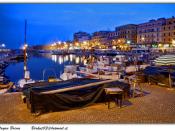The beautiful and delicate porcelains of China and Japan were taken to Europe after the opening of trade with Asia. They created such an intense fashion for fine porcelain with the ruling classes that it was called a "china mania." Kings vied with each other in attempts to discover the secret of true porcelain jealously guarded by the Asians. The nobility were no longer satisfied with vessels of opaque earthenware, and even gold and silver services gave way to the more highly prized porcelains.
As early as 1580 Francesco de' Medici had manufactured in Florence a ware with a translucent body called porcelain. This was not the true Chinese porcelain but a soft-paste porcelain made of various mixtures of white firing clay and glass, or frit. The manufacture of this soft-paste porcelain spread through France, Italy, and England until it was finally displaced by true, or hard-paste, porcelain, whose secret of manufacture became known in Europe.
Augustus II the Strong, elector of Saxony and king of Poland, wanted to make porcelain in Saxony and thus put an end to the spending of large sums of money for Chinese porcelains. He had in his employ a young alchemist, Johann Friedrich Bottger. Augustus was convinced that Bottger would be able to bring him great wealth if he knew or could find the secret of turning base metals into gold. He had Bottger held as a virtual prisoner while he paid him for his work. When Bottger failed, the king's patience was exhausted. He had him imprisoned in a fortress at Meissen, near Dresden.
There in 1706 Count von Tschirnhaus, a Saxon nobleman, got the king's permission to have Bottger help him. Bottger soon developed a red stoneware so hard it could only be cut on the jeweler's wheel. About this time...


